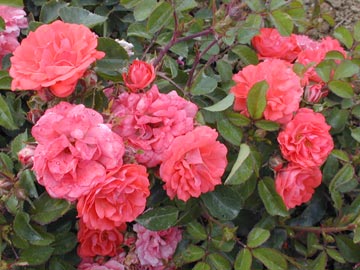A plant that’s covered in skin-piercing thorns and that’s prone to attack by more bugs and diseases than most any other plant had better have an astounding redeeming trait to earn its keep in the garden. The rose has at least two – good-looking flowers and some of the best fragrance this side of the cologne counters.
 Fragrance and stunning good looks make up for rose thorns and their propensity for bug and disease problems.
Fragrance and stunning good looks make up for rose thorns and their propensity for bug and disease problems.
© George Weigel, taken at Lewis Ginter Botanical Gardens, Richmond, VA
Roses have more common scents than just about any home-garden plant. That explains why so many gardeners are willing to spray, prune, pamper and suffer regular wounding in order to include a few roses in the landscape.
Most roses have maintained at least fair fragrance, a trait that has been a leading casualty of modern flower breeding. Recent flower production has focused largely on increased flowering, new colors, long bloom time, compact plant size and bug- and disease-resistance. In the effort to deliver as much of that as possible, fragrance has been the odd trait out. Even some roses aren’t very fragrant anymore, but so many are that the rose is still a top choice for those interested in fragrant yards.
Rose scent comes from the particular mix of plant oils in each rose variety. As many as 300 different primary oils can show up in a rose. Usually only four or five of them make up the main scent, which is called “base notes” in rosarian lingo. Not everyone agrees on which roses smell the best, though.
Different people have different opinions, and it’s common for different “sniffers” to describe what they smell in different terms. Some of that is due to how our differing olfactory systems assess each rose’s unique blend of plant oils. But research has found that roses can change their scents based on changing environmental factors.
Not all flowers on the same bush smell exactly the same either. Trained noses can pick up these differences. Try it yourself. Next time you’re rose-to-nose, try sniffing multiple flowers. See if you pick up any differences between, say, a rose high on the plant vs. one near the bottom, or a rose on the sunniest side of the plant vs. one on the back side.
One of the biggest differences is the change in scent as a rose flower ages. A newly opened bud may start out smelling fruity but morph more into a clove-like scent as the flower opens and matures. Neither do roses smell the same from year to year. Weather variations account for one significant difference. For example, warmer weather at bud time usually leads to a stronger scent at opening time, and roses tend to hold their scents longer when the weather is humid.
The type of soil and the nutrition in it is another smell-changer. Roses are heavy feeders and perform best when given regular and adequate doses of a fertilizer. Young roses (i.e. the first 2 years in the ground) benefit from three to four applications of this long-acting granular fertilizer per season, starting in spring, while established roses do well with two or three applications, starting in spring.
While most rose fragrance comes from glands at the base of the petals, some also comes from the stamens—those little pollen-holding projections inside the flower. That’s especially true in roses with single or semi-double flowers.
 Fragrance and stunning good looks make up for rose thorns and their propensity for bug and disease problems.
Fragrance and stunning good looks make up for rose thorns and their propensity for bug and disease problems.
© George Weigel
So for the best sniffing experience, sniff the stamens as well as around the petal perimeter. One good way to end up with your favorite smellers in your garden is to do some test-sniffs before buying.
That’s easy if you’re buying when the roses are in bloom, but another option is to visit a public garden. Many of them have rose collections, and that will give you a chance to smell even more choices than may be available at the local garden center.
Or if you trust other people’s sniffers more than your own, here are a dozen that have either won American Rose Society fragrance awards or are widely regarded as some of the most fragrant rose varieties:
- ‘Double Delight’ (a pink bicolor hybrid-tea type).
- ‘Mr. Lincoln’ (dark red hybrid tea.
- ‘Fragrant Cloud’ (orange/red hybrid tea).
- ‘Scentimental’ (burgundy and cream striped floribunda type).
- ‘Tiffany’ (pink/yellow blend hybrid tea).
- ‘Angel Face’ (lavender floribunda).
- ‘Chrysler Imperial’ (dark red hybrid tea).
- ‘Fragrant Cloud’ (coral red hybrid tea).
- ‘Sunsprite’ (yellow floribunda).
- ‘Miss All-American Beauty’ (pink hybrid tea).
- ‘Midas Touch’ (gold hybrid tea).
- ‘Honey Perfume’ (apricot/yellow floribunda).